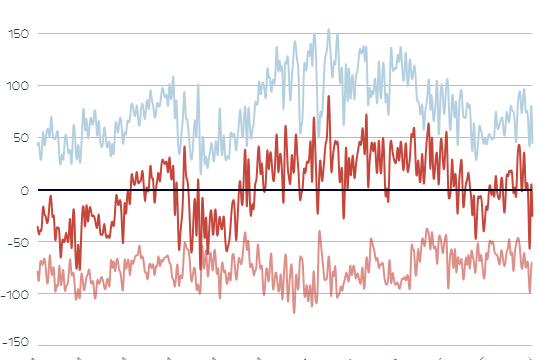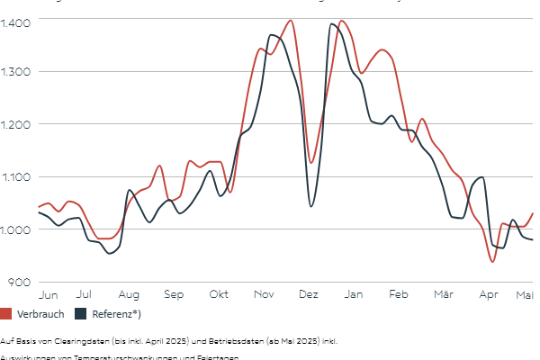Compared to May 2024, the renewable generation in May 2025 (calendar weeks 18-22) fell by almost a quarter (specifically by 22.9%). The main reason for this was the lower precipitation compared to the previous year.
The share of hydropower, which accounts for the majority of renewables at 3,351 GWh, fell significantly compared to the previous year (minus 3.0% compared to May 2024). Wind energy accounted for 595 GWh (plus 1.4 percent), while the PV feed-in contributed 761 GWh (plus 0.9 percent) to the generation of sustainable electricity.
Austria is once again an electricity importer
On balance, Austria (APG* control area) imported 105 GWh over the entire month of May (based on the schedules), with electricity being exported abroad on only twelve days. The picture was completely different in May 2024, when electricity exports were recorded on all 31 days, among other things, due to the good run-of-river feed-in, resulting in a net export of 1,300 GWh.
The comparison of the two monthly balances illustrates the extreme volatility of the overall electricity system in Austria at present.
A strong power grid is the basic prerequisite for an efficient energy transition
A secure electricity supply is the basis of a modern, sustainable, digital society and is essential for a resilient business location and place to live. To ensure that Austria will rank among the top countries when it comes to the security of supply, also in the future, a consistent modernization and expansion of the grid is necessary to create a high-capacity electricity infrastructure. If the grid is not or insufficiently expanded, the integration of renewable energies will be limited, dependence on imports increased, and thus Austria’s position as a business location and place to live will be weakened.
"A strong transmission grid ensures that renewable (and ideally also low-cost) electricity can be managed throughout Austria or that it can be provided through imports for Austria's electricity customers. An efficient grid infrastructure therefore not only paves the way for a comprehensive, efficient and improved integration of renewables in the Austria-wide system and thus facilitates the transformation towards an affordable, reliable and sustainable energy system, but is also essential to strengthen Austria’s position as a flourishing business location - especially with regard to the increasing electrification of all areas of life and the economy," says APG CTO Gerhard Christiner.
A strong grid is necessary to make the volatile, renewable electricity available and to transport it to where it is needed. To avoid grid overloads and ensure a secure supply, the electricity flow is managed with redispatch measures, i.e., the targeted use of controllable power plants.
In May 2025, interventions in the schedule of power plants in Austria were necessary on 5 days to avoid overloads of the grid. This is 9 days less than in May 2024. Overall, the picture of the first five months of 2025 is a different one. There was an increase compared to the previous year: In the first five months of 2025 (76 days to the end of May), ten more days of redispatching were necessary compared to the same period in the previous year (2024: 66 days). This underlines the urgent need for more grid capacity.
Redispatch measures are cost-intensive. These costs have to be borne by the electricity customers. Up to and including May, the costs for the first five months of the year amounted to €30.0 million, which again reflects the lack of grid capacities.
A negative effect, in addition to the costs and rising CO2 consumption, is the "curtailment" of renewable power plant production: For example, wind power plants or run-of-river power plants that would be producing electricity at a certain time are shut down to avoid overloads in the electricity grid. Since the beginning of the year, around 5,297 megawatt hours (i.e. an average of 1,059 MWh per month) of electricity have been "lost" due to these redispatch measures.
These figures illustrate the need for a modern, resilient, overall energy system with a high-capacity transmission grid infrastructure.
Energy exchange within Austria
The exchange of energy across Austria is managed via APG’s transmission grid. Electricity surpluses in individual provinces can thus be distributed throughout Austria to compensate for deficits.
In May, Carinthia (255 GWh) and Lower Austria (180 GWh) fed the highest volumes of energy into the APG grid and thus made it available throughout Austria. Vienna (411 GWh) and Carinthia (122 GWh) drew the most electricity from the APG grid.
Responsible electricity consumption
The latest available data show that 4,990 GWh of electricity were consumed from the public grid in Austria in May (calendar weeks 18-22) - around 1.4% more than in May 2025 (4,919 GWh). This is the electricity drawn from the public grid (including grid losses, excluding pumped electricity) in the APG control area. The figures do not include electricity produced and consumed by private PV units.
Tips for saving electricity can be found at www.apg.at/stromspartipps. With the APG Powermonitor, the Austrian population can see the most effective electricity-saving hours and thus make an active contribution to CO2 reduction and system security. The APG Powermonitor can be found at www.apg.at/powermonitor.
APG continually keeps track of the development of the domestic electricity industry and regularly publishes diagrams at https://www.apg.at/infografiken regarding the topics: energy exchange, energy consumption in Austria, renewables production, import/export, electricity prices, etc.
* The APG control area comprises almost all of Austria with the exception of a corridor each in Vorarlberg and Tyrol.
About Austrian Power Grid (APG)
As independent transmission system operator Austrian Power Grid (APG) is in charge of ensuring the security of the electricity supply in Austria. With our high-performance and digital electricity infrastructure and the use of state-of-the-art technologies we integrate renewable energies and reduce the dependency on electricity imports, we are the platform for the electricity market, and we provide access to reasonably priced electricity and thus create the basis for Austria as supply-secure and future-oriented industrial and business location and place to live. The APG grid totals a length of about 3,500 km and is operated, maintained, and continuously adapted to the increasing challenges of the electrification of businesses, industry, and society by a team of approximately 1,000 specialists. 67 substations are distributed all over Austria and the majority is operated remotely. Thanks to our committed employees Austria had a security of supply of 99.99 percent also in 2024 and thus ranks among the top countries worldwide. Our investments of 630 million euros in 2025 (2024: 440 million euros, 2023: 490 million euros) are a motor for the Austrian economy and a crucial factor in reaching Austria’s climate and energy targets. Until 2034 APG will invest a total of approximately 9 billion euros in grid expansion and renovation projects.
Press contact
Christoph Schuh




